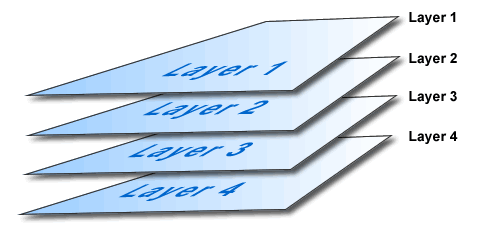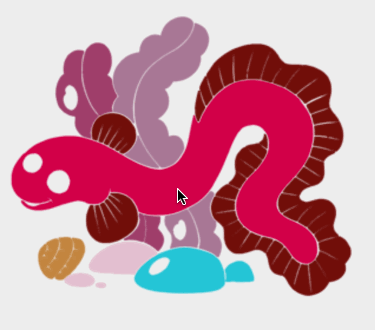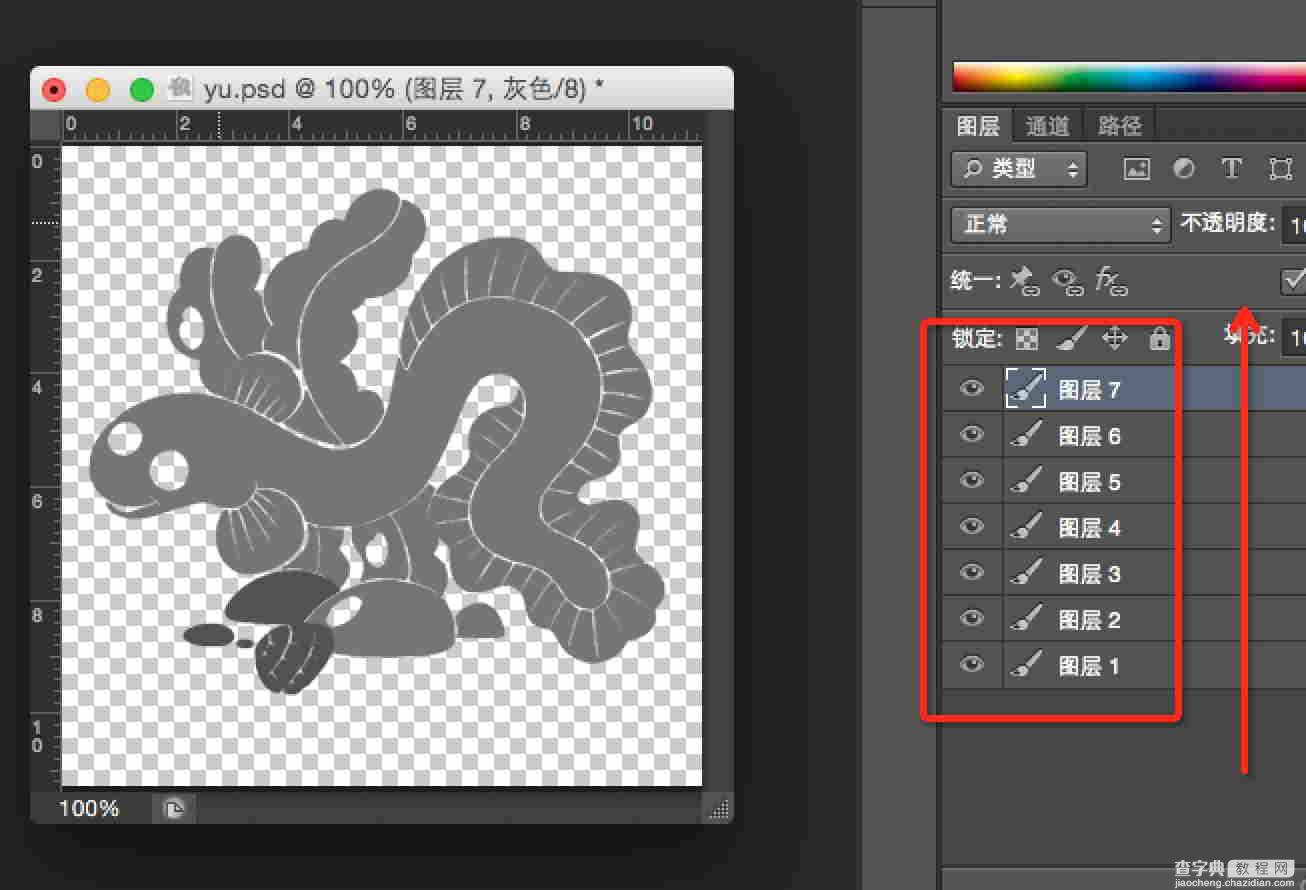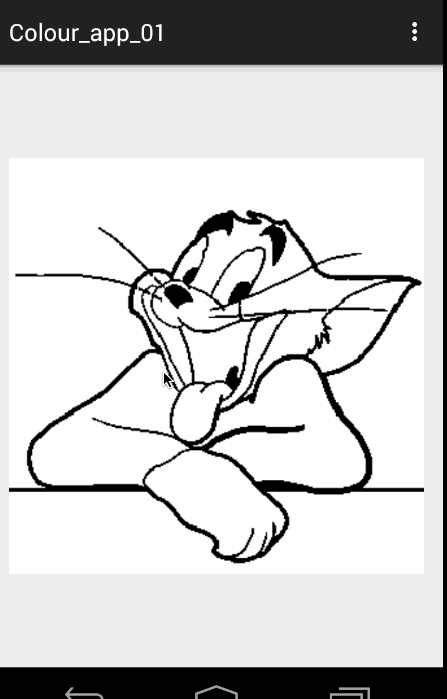一、着色游戏概述
近期群里偶然看到一哥们在群里聊不规则图像填充什么四联通、八联通什么的,就本身好学务实的态度去查阅了相关资料。对于这类着色的资料,最好的就是去搜索些相关app,根据我的观察呢,不规则图像填充在着色游戏里面应用居多,不过大致可以分为两种:
基于层的的填充 基于边界的填充
那么针对上述两种,我们会通过两篇博文来讲解,本篇就是叙述基于层的填充方式,那么什么基于层的填充方式呢?其实就是一张图实际上是由多个层组成的,每个层显示部分图像(无图像部分为透明),多层叠加后形成一张完整的图案,图层间是叠加的关系,类似下图。

相信大家如果学过PS,对上述肯定再了解不过了。比如你要绘制一个天空,你可以最底层去绘制蓝天,在上层绘制白云,再上层会执行小鸟。然后三层叠加以后就是一副小鸟在天空翱翔的图了。
二、效果与分析
好了,接下来看下今天的效果。

ok,可以看到一个简单的着色效果,其实原理很简单,首先呢,该图实际上是由7层组成:
例如下图。

那么如果我们需要给这幅图的某个位置着色,实际上是给某一层的非透明区域着色。实际上就转化为:
用户点击的(x,y)-> 判断落在哪一层的非透明区域 -> 然后给该层非透明区域着色。
ok,这样原理就叙述清楚了,实际上也是非常的简单,基于该原理,我们可以自定义一个View,然后一幅一幅去绘制图层,最后按照上述步骤去编写代码。不过,我们还有可以偷懒的地方,其实没必要我们自己去一个图层一个图层的绘制,我们可以利用Drawable去完成图层叠加的工作,我们有一类Drawable叫做LayerDrawable,对应的xml为layer-list,我们可以通过使用LayerDrawable极大的简化我们的工作。
三、编码与实现
上述已经描述很清楚了,我再给大家细化一下:
layer-list中去定义我们的drawable
然后把该drawable作为我们View的背景
复写onTouchEvent方法
判断用户点击的坐标落在哪一层的非透明位置,改变该层非透明区域颜色
(一)layer-list
<"1.0" encoding="utf-8"?> <layer-list xmlns:android="http://schemas.android.com/apk/res/android"> <item android:drawable="@drawable/eel_mask1"/> <item android:drawable="@drawable/eel_mask2"/> <item android:drawable="@drawable/eel_mask3"/> <item android:drawable="@drawable/eel_mask4"/> <item android:drawable="@drawable/eel_mask5"/> <item android:drawable="@drawable/eel_mask6"/> <item android:drawable="@drawable/eel_mask7"/> </layer-list>
ok,这样我们的drawable就ok了~~没撒说的,不过layer-list可以做很多事情,大家可以关注下。
(二)View代码
package com.zhy.colour_app_01; import android.content.Context; import android.graphics.Bitmap; import android.graphics.Color; import android.graphics.PorterDuff; import android.graphics.drawable.BitmapDrawable; import android.graphics.drawable.Drawable; import android.graphics.drawable.LayerDrawable; import android.util.AttributeSet; import android.util.Log; import android.view.MotionEvent; import android.view.View; import java.util.Random; /** * Created by zhy on 15/5/14. */ public class ColourImageBaseLayerView extends View { private LayerDrawable mDrawables; public ColourImageBaseLayerView(Context context, AttributeSet attrs) { super(context, attrs); mDrawables = (LayerDrawable) getBackground(); } @Override protected void onMeasure(int widthMeasureSpec, int heightMeasureSpec) { setMeasuredDimension(mDrawables.getIntrinsicWidth(), mDrawables.getIntrinsicHeight()); } @Override public boolean onTouchEvent(MotionEvent event) { final float x = event.getX(); final float y = event.getY(); if (event.getAction() == MotionEvent.ACTION_DOWN) { Drawable drawable = findDrawable(x, y); if (drawable != null) drawable.setColorFilter(randomColor(), PorterDuff.Mode.SRC_IN); } return super.onTouchEvent(event); } private int randomColor() { Random random = new Random(); int color = Color.argb(255, random.nextInt(256), random.nextInt(256), random.nextInt(256)); return color; } private Drawable findDrawable(float x, float y) { final int numberOfLayers = mDrawables.getNumberOfLayers(); Drawable drawable = null; Bitmap bitmap = null; for (int i = numberOfLayers - 1; i >= 0; i--) { drawable = mDrawables.getDrawable(i); bitmap = ((BitmapDrawable) drawable).getBitmap(); try { int pixel = bitmap.getPixel((int) x, (int) y); if (pixel == Color.TRANSPARENT) { continue; } } catch (Exception e) { continue; } return drawable; } return null; } }
ok,代码也比较简单,首先我们把drawable作为view的背景,然后在构造中获取drawable(LayerDrawable)。接下来复写onTouchEvent,捕获用户点击的(x,y),根据(x,y)去找出当前点击的是哪一层(必须点击在非透明区域),最后通过设置setColorFilter去改变颜色即可~很easy吧最后贴下布局文件:
(三)布局文件
<RelativeLayout xmlns:android="http://schemas.android.com/apk/res/android" xmlns:tools="http://schemas.android.com/tools" android:layout_width="match_parent" android:layout_height="match_parent" android:paddingLeft="@dimen/activity_horizontal_margin" android:paddingRight="@dimen/activity_horizontal_margin" android:paddingTop="@dimen/activity_vertical_margin" android:paddingBottom="@dimen/activity_vertical_margin" tools:context=".MainActivity"> <com.zhy.colour_app_01.ColourImageBaseLayerView android:background="@drawable/eel" android:layout_width="match_parent" android:layout_centerInParent="true" android:layout_height="match_parent"/> </RelativeLayout>
四、边界的填充
1.图像的填充有2种经典算法。
一种是种子填充法。种子填充法理论上能够填充任意区域和图形,但是这种算法存在大量的反复入栈和大规模的递归,降低了填充效率。
另一种是扫描线填充法。
注意:实际上图像填充的算法还是很多的,有兴趣可以去Google学术上去搜一搜。
ok,下面先看看效果图:

ok,可以看到这样的颜色填充比上一篇的基于层的在素材的准备上要easy 很多~~~
2.原理分析
首先我们简述下原理,我们在点击的时候拿到点击点的”颜色”,然后按照我们选择的算法进行填色即可。
算法1:种子填充法,四联通/八联通
算法简介:假设要将某个区域填充成红色。
从用户点击点的像素开始,上下左右(八联通还有左上,左下,右上,右下)去判断颜色,如果四个方向上的颜色与当前点击点的像素一致,则改变颜色至目标色。然后继续上述这个过程。
ok,可以看到这是一个递归的过程,1个点到4个,4个到16个不断的去延伸。如果按照这种算法,你会写出类似这样的代码:
/** * @param pixels 像素数组 * @param w 宽度 * @param h 高度 * @param pixel 当前点的颜色 * @param newColor 填充色 * @param i 横坐标 * @param j 纵坐标 */ private void fillColor01(int[] pixels, int w, int h, int pixel, int newColor, int i, int j) { int index = j * w + i; if (pixels[index] != pixel || i >= w || i < 0 || j < 0 || j >= h) return; pixels[index] = newColor; //上 fillColor01(pixels, w, h, pixel, newColor, i, j - 1); //右 fillColor01(pixels, w, h, pixel, newColor, i + 1, j); //下 fillColor01(pixels, w, h, pixel, newColor, i, j + 1); //左 fillColor01(pixels, w, h, pixel, newColor, i - 1, j); }
代码很简单,但是如果你去运行,会发生StackOverflowException异常,这个异常主要是因为大量的递归造成的。虽然简单,但是在移动设备上使用该方法不行。
于是,我就想,这个方法不是递归深度过多么,那么我可以使用一个Stack去存像素点,减少递归的深度和次数,于是我把代码改成如下的方式:
/** * @param pixels 像素数组 * @param w 宽度 * @param h 高度 * @param pixel 当前点的颜色 * @param newColor 填充色 * @param i 横坐标 * @param j 纵坐标 */ private void fillColor(int[] pixels, int w, int h, int pixel, int newColor, int i, int j) { mStacks.push(new Point(i, j)); while (!mStacks.isEmpty()) { Point seed = mStacks.pop(); Log.e("TAG", "seed = " + seed.x + " , seed = " + seed.y); int index = seed.y * w + seed.x; pixels[index] = newColor; if (seed.y > 0) { int top = index - w; if (pixels[top] == pixel) { mStacks.push(new Point(seed.x, seed.y - 1)); } } if (seed.y < h - 1) { int bottom = index + w; if (pixels[bottom] == pixel) { mStacks.push(new Point(seed.x, seed.y + 1)); } } if (seed.x > 0) { int left = index - 1; if (pixels[left] == pixel) { mStacks.push(new Point(seed.x - 1, seed.y)); } } if (seed.x < w - 1) { int right = index + 1; if (pixels[right] == pixel) { mStacks.push(new Point(seed.x + 1, seed.y)); } } } }
方法的思想也比较简单,将当前像素点入栈,然后出栈着色,接下来分别判断四个方向的,如果符合条件也进行入栈(只要栈不为空持续运行)。ok,这个方法我也尝试跑了下,恩,这次不会报错了,但是速度特别的慢~~~~慢得我是不可接受的。(有兴趣可以尝试,记得如果ANR,点击等待)。
这样来看,第一种算法,我们是不考虑了,没有办法使用,主要原因是假设对于矩形同色区域,都是需要填充的,而算法一依然是各种入栈。于是考虑第二种算法
扫描线填充法
详细可参考 扫描线种子填充算法的解析和扫描线种子填充算法。
算法思想:
初始化一个空的栈用于存放种子点,将种子点(x, y)入栈;
判断栈是否为空,如果栈为空则结束算法,否则取出栈顶元素作为当前扫描线的种子点(x, y),y是当前的扫描线;
从种子点(x, y)出发,沿当前扫描线向左、右两个方向填充,直到边界。分别标记区段的左、右端点坐标为xLeft和xRight;
分别检查与当前扫描线相邻的y - 1和y + 1两条扫描线在区间[xLeft, xRight]中的像素,从xRight开始向xLeft方向搜索,假设扫描的区间为AAABAAC(A为种子点颜色),那么将B和C前面的A作为种子点压入栈中,然后返回第(2)步;
上述参考自参考文献[4],做了些修改,文章[4]中描述算法,测试有一点问题,所以做了修改.
可以看到该算法,基本上是一行一行着色的,这样的话在大块需要着色区域的效率比算法一要高很多。
ok,关于算法的步骤大家目前觉得模糊,一会可以参照我们的代码。选定了算法以后,接下来就开始编码了。
3.编码实现
我们代码中引入了一个边界颜色,如果设置的话,着色的边界参考为该边界颜色,否则会只要与种子颜色不一致为边界。
(一)构造方法与测量
public class ColourImageView extends ImageView { private Bitmap mBitmap; /** * 边界的颜色 */ private int mBorderColor = -1; private boolean hasBorderColor = false; private Stack<Point> mStacks = new Stack<Point>(); public ColourImageView(Context context, AttributeSet attrs) { super(context, attrs); TypedArray ta = context.obtainStyledAttributes(attrs, R.styleable.ColourImageView); mBorderColor = ta.getColor(R.styleable.ColourImageView_border_color, -1); hasBorderColor = (mBorderColor != -1); L.e("hasBorderColor = " + hasBorderColor + " , mBorderColor = " + mBorderColor); ta.recycle(); } @Override protected void onMeasure(int widthMeasureSpec, int heightMeasureSpec) { super.onMeasure(widthMeasureSpec, heightMeasureSpec); int viewWidth = getMeasuredWidth(); int viewHeight = getMeasuredHeight(); //以宽度为标准,等比例缩放view的高度 setMeasuredDimension(viewWidth, getDrawable().getIntrinsicHeight() * viewWidth / getDrawable().getIntrinsicWidth()); L.e("view's width = " + getMeasuredWidth() + " , view's height = " + getMeasuredHeight()); //根据drawable,去得到一个和view一样大小的bitmap BitmapDrawable drawable = (BitmapDrawable) getDrawable(); Bitmap bm = drawable.getBitmap(); mBitmap = Bitmap.createScaledBitmap(bm, getMeasuredWidth(), getMeasuredHeight(), false); }
可以看到我们选择的是继承ImageView,这样只需要将图片设为src即可。
构造方法中获取我们的自定义边界颜色,当然可以不设置~~
重写测量的目的是为了获取一个和View一样大小的Bitmap便于我们操作。
接下来就是点击啦~
4.onTouchEvent
@Override public boolean onTouchEvent(MotionEvent event) { final int x = (int) event.getX(); final int y = (int) event.getY(); if (event.getAction() == MotionEvent.ACTION_DOWN) { //填色 fillColorToSameArea(x, y); } return super.onTouchEvent(event); } /** * 根据x,y获得改点颜色,进行填充 * * @param x * @param y */ private void fillColorToSameArea(int x, int y) { Bitmap bm = mBitmap; int pixel = bm.getPixel(x, y); if (pixel == Color.TRANSPARENT || (hasBorderColor && mBorderColor == pixel)) { return; } int newColor = randomColor(); int w = bm.getWidth(); int h = bm.getHeight(); //拿到该bitmap的颜色数组 int[] pixels = new int[w * h]; bm.getPixels(pixels, 0, w, 0, 0, w, h); //填色 fillColor(pixels, w, h, pixel, newColor, x, y); //重新设置bitmap bm.setPixels(pixels, 0, w, 0, 0, w, h); setImageDrawable(new BitmapDrawable(bm)); }
可以看到,我们在onTouchEvent中获取(x,y),然后拿到改点坐标:
获得点击点颜色,获得整个bitmap的像素数组
改变这个数组中的颜色
然后重新设置给bitmap,重新设置给ImageView
重点就是通过fillColor去改变数组中的颜色
/** * @param pixels 像素数组 * @param w 宽度 * @param h 高度 * @param pixel 当前点的颜色 * @param newColor 填充色 * @param i 横坐标 * @param j 纵坐标 */ private void fillColor(int[] pixels, int w, int h, int pixel, int newColor, int i, int j) { //步骤1:将种子点(x, y)入栈; mStacks.push(new Point(i, j)); //步骤2:判断栈是否为空, // 如果栈为空则结束算法,否则取出栈顶元素作为当前扫描线的种子点(x, y), // y是当前的扫描线; while (!mStacks.isEmpty()) { /** * 步骤3:从种子点(x, y)出发,沿当前扫描线向左、右两个方向填充, * 直到边界。分别标记区段的左、右端点坐标为xLeft和xRight; */ Point seed = mStacks.pop(); //L.e("seed = " + seed.x + " , seed = " + seed.y); int count = fillLineLeft(pixels, pixel, w, h, newColor, seed.x, seed.y); int left = seed.x - count + 1; count = fillLineRight(pixels, pixel, w, h, newColor, seed.x + 1, seed.y); int right = seed.x + count; /** * 步骤4: * 分别检查与当前扫描线相邻的y - 1和y + 1两条扫描线在区间[xLeft, xRight]中的像素, * 从xRight开始向xLeft方向搜索,假设扫描的区间为AAABAAC(A为种子点颜色), * 那么将B和C前面的A作为种子点压入栈中,然后返回第(2)步; */ //从y-1找种子 if (seed.y - 1 >= 0) findSeedInNewLine(pixels, pixel, w, h, seed.y - 1, left, right); //从y+1找种子 if (seed.y + 1 < h) findSeedInNewLine(pixels, pixel, w, h, seed.y + 1, left, right); } }
可以看到我已经很清楚的将该算法的四个步骤标识到该方法中。好了,最后就是一些依赖的细节上的方法:
/** * 在新行找种子节点 * * @param pixels * @param pixel * @param w * @param h * @param i * @param left * @param right */ private void findSeedInNewLine(int[] pixels, int pixel, int w, int h, int i, int left, int right) { /** * 获得该行的开始索引 */ int begin = i * w + left; /** * 获得该行的结束索引 */ int end = i * w + right; boolean hasSeed = false; int rx = -1, ry = -1; ry = i; /** * 从end到begin,找到种子节点入栈(AAABAAAB,则B前的A为种子节点) */ while (end >= begin) { if (pixels[end] == pixel) { if (!hasSeed) { rx = end % w; mStacks.push(new Point(rx, ry)); hasSeed = true; } } else { hasSeed = false; } end--; } } /** * 往右填色,返回填充的个数 * * @return */ private int fillLineRight(int[] pixels, int pixel, int w, int h, int newColor, int x, int y) { int count = 0; while (x < w) { //拿到索引 int index = y * w + x; if (needFillPixel(pixels, pixel, index)) { pixels[index] = newColor; count++; x++; } else { break; } } return count; } /** * 往左填色,返回填色的数量值 * * @return */ private int fillLineLeft(int[] pixels, int pixel, int w, int h, int newColor, int x, int y) { int count = 0; while (x >= 0) { //计算出索引 int index = y * w + x; if (needFillPixel(pixels, pixel, index)) { pixels[index] = newColor; count++; x--; } else { break; } } return count; } private boolean needFillPixel(int[] pixels, int pixel, int index) { if (hasBorderColor) { return pixels[index] != mBorderColor; } else { return pixels[index] == pixel; } } /** * 返回一个随机颜色 * * @return */ private int randomColor() { Random random = new Random(); int color = Color.argb(255, random.nextInt(256), random.nextInt(256), random.nextInt(256)); return color; }
ok,到此,代码就介绍完毕了~~~
最后贴下布局文件~~
<RelativeLayout xmlns:android="http://schemas.android.com/apk/res/android" xmlns:tools="http://schemas.android.com/tools" xmlns:zhy="http://schemas.android.com/apk/res-auto" android:layout_width="match_parent" android:layout_height="match_parent" android:paddingLeft="@dimen/activity_horizontal_margin" android:paddingRight="@dimen/activity_horizontal_margin" android:paddingTop="@dimen/activity_vertical_margin" android:paddingBottom="@dimen/activity_vertical_margin" tools:context=".MainActivity"> <com.zhy.colour_app_01.ColourImageView zhy:border_color="#FF000000" android:src="@drawable/image_007" android:background="#33ff0000" android:layout_width="match_parent" android:layout_centerInParent="true" android:layout_height="match_parent"/> </RelativeLayout> <"1.0" encoding="utf-8"?> <resources> <declare-styleable name="ColourImageView"> <attr name="border_color" format="color|reference"></attr> </declare-styleable> </resources>
【以一个着色游戏展开讲解Android中区域图像填色的方法】相关文章:
★ Android编程之客户端通过socket与服务器通信的方法
